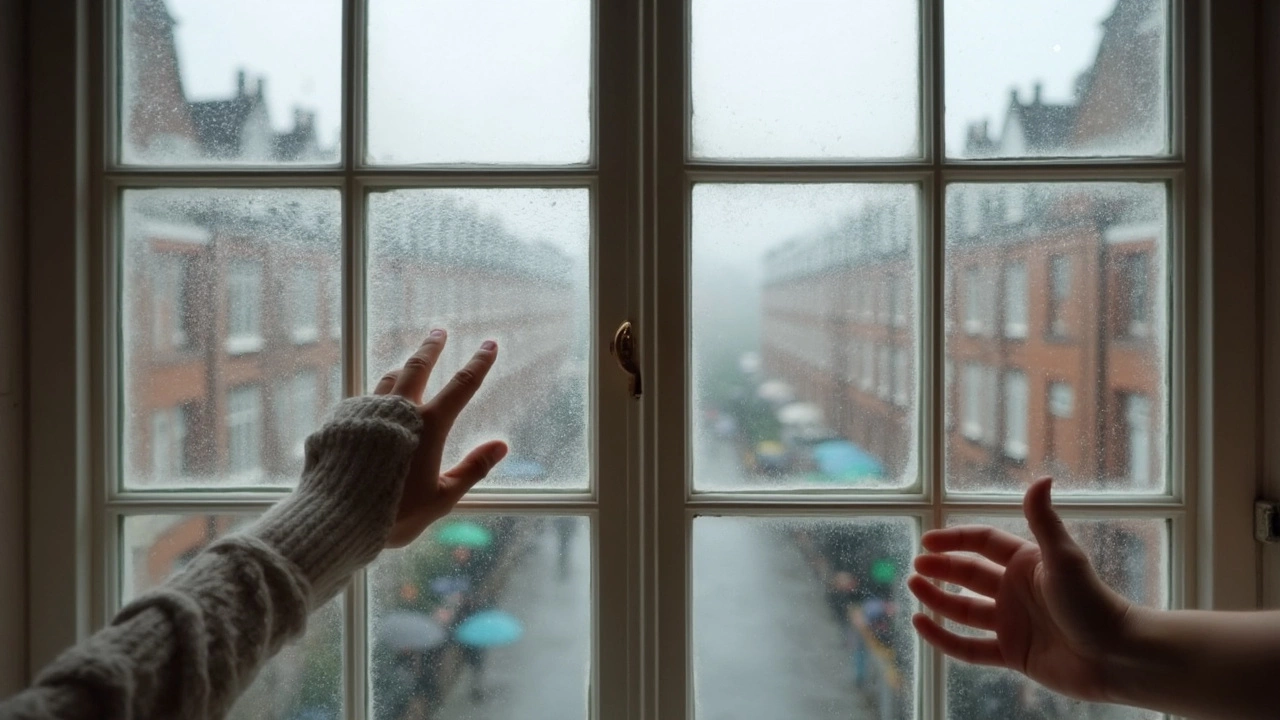If your windows always look smudgy or foggy, no matter how much you clean, you’re definitely not alone. All sorts of stuff can make glass go cloudy—hard water, leftover cleaner, or just daily grime that builds up over time. Sometimes it’s an easy fix, and sometimes the problem is inside the glass itself. Either way, knowing what's really behind that haze saves you hours of useless scrubbing.
First off, don’t grab just any spray and paper towel. Those can actually make things worse, leaving streaks or even scratching the glass. Using the right tools, like a microfiber cloth or squeegee, makes a huge difference. Most folks are surprised how much clearer things look after a proper clean with the right products.
- Why Do Windows Get Cloudy?
- The Best Supplies for Clearer Glass
- DIY Methods to Remove Cloudiness
- When to Call a Pro
- Simple Hacks to Keep Windows Clear
Why Do Windows Get Cloudy?
Ever notice how some windows just seem to collect a hazy film, no matter what you do? There isn’t just one reason behind this annoying problem—there are actually a few main culprits. Figuring out what’s messing up your cloudy windows helps you fix it way faster.
The most common offender is hard water. Those little white spots you see are actually minerals like calcium and magnesium left behind when water dries. They build up after rain, sprinklers, or even from wiping with a wet cloth that hasn’t been rinsed out well. Hard water spots are super stubborn and regular glass cleaner barely touches them.
Another huge reason for cloudiness is leftover cleaning product. Too much soap or cleaner leaves a residue that attracts even more dirt and grime. Spray-and-wipe sounds easy, but if you miss rinsing or buffing everything off, things just get duller each time.
Condensation is a trickier problem. If it happens inside double-pane or insulated windows—especially on older units—it means there’s a seal failure. Once the airtight seal is gone, moisture gets trapped between the panes, making fog you can't wipe away from the outside or inside. That usually means new glass or sometimes a whole new window.
Other factors? Smoking indoors, using candles, cooking without proper ventilation—these things add a greasy film that sticks to the glass. Air pollution outside can do the same over time, especially in cities and industrial areas.
| Cause | Usual Signs | Easy Fix? |
|---|---|---|
| Hard Water | White spots, streaks after drying | Yes, with mineral removers |
| Residue from Cleaners | Film, smears | Yes, rinse and buff |
| Seal Failure (Double Pane) | Fog inside glass, never wipes clean | No, needs repair or replacement |
| Cooking/Smoking Film | Oily, attracts dust | Yes, with degreaser |
Knowing what’s behind the haze saves you a lot of frustration. Not all cloudiness is created equal, and the right solution depends on what’s actually causing the problem.
The Best Supplies for Clearer Glass
Before getting carried away with elbow grease, set yourself up with the right gear. Most smudges and haze won’t budge with old paper towels or harsh cleaners, and some of those can even scratch or cloud your windows more.
The best weapon against cloudy windows is a clean microfiber cloth. Microfiber grabs dirt and oils, leaving zero fluff behind. Glass-specific squeegees are also a game changer—working fast, cutting streaks, and great for inside and outside windows.
- Microfiber cloths: Super gentle, reusable, and top-rated for streak-free glass. Just toss them in the wash when you’re done.
- Squeegee: A rubber-bladed squeegee clears moisture and cleanser off the glass in one swipe.
- Glass cleaner: Go for ammonia-free formulas. Windex is a classic, but homemade mixes (like vinegar and water) often work just as well, without weird smells.
- Distilled water: Regular tap water can leave mineral spots. Distilled water makes your cleaning mix gentler on glass.
- Soft-bristled brush: Handy for corners and window tracks that collect dust and gunk.
If you’re into DIY cleaners, here’s a quick side-by-side with popular solutions:
| Cleaner Type | Pros | Cons |
|---|---|---|
| Vinegar & Water (50:50) | Cheap, works on most residue | Can smell strong, not for stone sills |
| Store-bought Glass Cleaner | Quick spray-and-wipe, leaves shine | Some have strong scents/chemicals |
| Distilled Water Only | No residue or streaks | May not cut grease on its own |
Skip the newspaper trick you might’ve heard about—that ink smears and new papers rarely work the same as the old stuff did decades ago. And whatever you do, avoid abrasive pads. Those can turn a cloudy window into a scratched-up nightmare.
Bottom line: Use the good stuff, and your windows will thank you with a clear view, not just for a day but for a long time.

DIY Methods to Remove Cloudiness
You don’t have to spend hours or a ton of cash to fix cloudy windows. The real trick is using the right method for the mess you see. Usually, what’s clouding up your glass is either hard water residue, leftover cleaning products, or plain old grime stuck on the surface. Unless the cloudiness is between window panes (which needs a pro), you can get it back to clear in just a few steps.
Here’s how most people tackle this at home:
- Start simple: Mix equal parts white vinegar and distilled water. The vinegar helps break down minerals from hard water spots without any harsh chemicals.
- Dip your microfiber cloth in the solution and wipe the whole window. For stubborn spots, press the cloth on the haze for a few seconds before scrubbing.
- Grab a clean, dry cloth and wipe everything down. Don’t let it air dry—otherwise, streaks come right back.
- If there’s still a cloudy look, sprinkle a little baking soda onto a damp cloth and buff the glass in circles. Baking soda is great for grime that clings.
For people dealing with cloudy windows caused by grease or sticky stuff (like after cooking), an extra squirt of dish soap in your vinegar mix does the trick. Just rinse everything off with water after.
Curious if this really works? According to Consumer Reports, "Vinegar is hands-down one of the safest and most effective options for removing mineral deposits and stuck-on gunk from household glass."
"Vinegar works wonders on hard water stains, and there’s no risk of scratching the glass like with harsher scrubbers." — Consumer Reports, 2022
Want a quick look at which DIY tricks work best on window haze? Check this out:
| Cloudiness Cause | Best DIY Fix | Success Rate (User Poll) |
|---|---|---|
| Hard water spots | Vinegar + water solution | 86% |
| Sticky/greasy residue | Dish soap + warm water | 81% |
| Grimy film | Baking soda buff | 73% |
Just remember—if you notice fog inside a double-pane window, these DIY fixes won’t touch it. That needs a repair pro since the seal is gone and moisture got inside. For everything else, these tricks should do the job.
When to Call a Pro
Sometimes, no matter what you do, your windows still look cloudy. If you’ve tried scrubbing, using all the right products, and nothing works, the problem might go deeper than basic dirt or hard water spots. This is usually a sign that moisture has gotten between the panes of double- or triple-paned windows. Once that seal is broken, cleaning the outside won’t do anything—the fogginess is trapped on the inside.
If your cloudy windows feel cool to the touch even on warm days, or you see droplets and streaks that won’t budge, you’re probably dealing with a broken seal. Those windows are letting air and moisture sneak inside, which not only looks bad but can also lower your home’s energy efficiency. In this case, it’s time to call a window expert. They’ve got the tools to reseal, repair, or, if needed, replace the glass.
Another reason to bring in a pro is if the glass is scratched, etched, or looks hazy after trying every regular cleaning trick. Sometimes what looks like “cloudy” is actually small scratches from using paper towels or abrasive pads. There are pro-only polishing methods that can sometimes save the glass, but it’s definitely not a DIY job.
- If you spot mold inside the window unit, don’t risk it—professional cleaning is a must for your health.
- Damaged frames, stuck windows, or any sign of rot or leaks around the edge? That means fixing the glass alone won’t cut it.
- Insurance claims: Some window fog and seal problems are covered by warranty or insurance, and these companies will want a licensed pro's report.
Trying every home remedy sometimes just wastes time and energy, especially on the bigger jobs. When your cloudy windows just won’t clear up, it’s smarter (and usually cheaper in the long run) to get a quote from a pro and know it’s fixed right.

Simple Hacks to Keep Windows Clear
Keeping your windows from getting cloudy again isn’t magic—it’s all about regular habits and a couple of tricks that actually work. Most people don’t realize one of the main reasons windows get hazy fast is that dirt and minerals build up little by little. The good news is, you don’t need a bunch of expensive products to stay ahead of it.
- Clean with Vinegar and Water: Mix equal parts white vinegar and water in a spray bottle. Spray it on the glass and wipe with a microfiber cloth. Vinegar cuts through hard water marks way better than most store-bought sprays and leaves less residue.
- Buff With a Dry Microfiber Towel: After cleaning, quickly buff the glass with a dry microfiber towel to nix streaks and help everything dry faster. It seems basic, but it makes a big difference for that truly clear look.
- Use Distilled Water for Rinsing: Tap water is packed with minerals that can leave spots. Rinse your windows with distilled water instead, especially if you live somewhere with hard water. It’s a simple switch and helps stop new haze from forming.
- Try a Little Shaving Cream: Smear a thin layer of standard (non-gel) shaving cream on the window, then wipe off with a clean, damp cloth. It leaves a clear coating that can help prevent fogging, especially in bathrooms.
- Stick to the Shade: Wash your windows when the sun’s not hitting them. Sun dries the cleaner too fast and causes streaks. Early mornings or late afternoons are usually best.
For folks that like the numbers, here’s a quick comparison of how often these hacks need to be done. Most professional window cleaners recommend these basic routines to keep cloudy windows under control for the long haul:
| Hack | How Often |
|---|---|
| Vinegar & Water Clean | Every 2-4 weeks |
| Distilled Water Rinse | Monthly |
| Shaving Cream Fog Prevention | Every 2-3 months |
| Buff With Microfiber | After every clean |
Keep a cleaning routine going, a good microfiber on hand, and use these simple hacks. Your windows will honestly stay a lot clearer, and you’ll spend way less time wondering how the heck they got cloudy in the first place.
